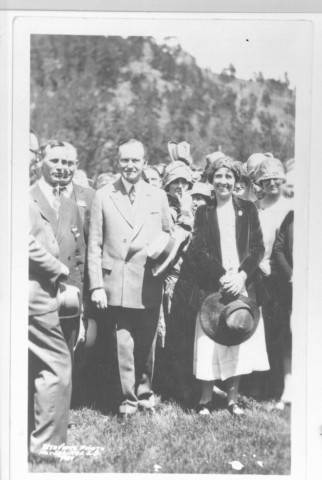
The Coolidges at Hot Springs, South Dakota, summer of 1927. Courtesy of South Dakota Digital Archives.
Mr. Lawrence W. Reed over at the Foundation for Economic Education has written a good reminder today about one of the most repeated myths regarding Calvin Coolidge and the Roaring Twenties: That all of it was responsible for the devastating economic plummet of the Thirties.
Mr. Reed’s analogy about washed cars and rain illustrates the very absence of a logical grasp of the issues when it comes to this attack on Cal. It is easier, though, to remake him into a caricature than to exert the effort to understand him and his ideas. It is easier to blame what came before the disaster than to reckon with those truly responsible: the decision-makers and policy experts of the Hoover and FDR administrations. It was widely noted at the time by numerous observers how dramatic a sea change truly did occur with the departure of the Coolidges from Washington in 1929. It began long before FDR came to town. Even before the 1932 campaign entered full swing, the steady vilification by New Deal advocates (before the term was even coined) of those corrupt, greedy, grasping Twenties remains a persistent impression today. It remains just as flawed and downright incorrect.
It was Coolidge’s substantial record of successes that were the envy of contemporary officeholders because he delivered while they could only posture and promise. None of his accomplishments rested on pandering guarantees or any of the typical electioneering litany of empty promises. He succeeded where others failed. That method and model had to go if business as usual was to prevail. Of first importance, though, was Coolidge’s reputation. Blame him for the depression and it accomplishes both goals: Destroy personal credibility and replace supposed failure of his governing approach.
Such is the handicapping result of this myth. Coolidge did help but not in the way his detractors claim: Consistently unassuming to the end, he was indifferent to any self-preservation or thoroughly explained defense of his record. His early passing only hastened this upheaval and denial of Coolidge’s successes.
Emotion will always be a part of politics. The fallout of guilt by proximity is as old as human experience. Coolidge distinguished the difference between proximity and actual guilt. He held doggedly to that principle in the days when the pressures of Teapot Dome could have implicated an entire company of innocent people on that basis of association alone. He held firm when the temptation was strongest to say nothing regarding race relations, delivering strong rebukes to Sergeant Gardner, to Congress on the crime of lynching, and before the crowds of Omaha (and those listening nationwide), where riots had torn the city. With Mr. Coolidge we are shown a better way, a way that deserves a fair and honest reappraisal. He deserves better than the myth and America has a duty to render at least this measure of appreciation for the service he bestowed not only in his time but for generations yet to be born.
Economist Milton Friedman in his book “Free to Choose” indicates that the cause of the “Great” Depression was a neophyte Federal Reserve Bank which was involved in an internal power struggle between the Federal Reserve Bank of New York and the Central Board in Washington. The Central Board won out and did what Washington bureaucrats almost always do: they did nothing and actually increased the discount rate at a time when the fractionary banking system was beginning to implode. This occurred beginning in December, 1930, when 352 banks failed. Ultimately 10,000 banks were to fail and be liquidated resolved or merged with other banks.
If this explanation is good enough for Milton Friedman, then it is good enough for me.
It wasn’t business or President Coolidge who caused the depression. It was government that caused it through the creation of the Federal Reserve which failed the American People miserably in its mission to be the lender of last resort.
Was there a “deep state” in operation back in the late 1920s and 1930s over at the Fed which may have wanted to make a constitutional conservative like Coolidge, (who happened to cut the Federal budget by 35%) look bad by allowing the banking system to implode? This is an interesting thought to contemplate as the far reaching tentacles of the deep state are currently being exposed for all to see.